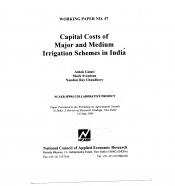Capital Costs of major & Medium irrigation Scheme in India
Ashok Gulati
Mark Svendsen
Nandini Roy Choudhury
April 1994
Irrigation has been a major contributing factor in the Green Revolution experienced by India during the late 1960s and the 1970s. While the considerable achievements of the irrigation sector have been appreciated by all, there has been very little attempt at estimating the cost at which this achievement has taken place. The estimates of cost generated so far by various government groups and agencies suffer from serious limitations in term of methodology and have resulted in gross under-estimation of real costs of investments in this sector. The present paper attempts to estimate the cost incurred in the development of surface irrigation schemes – both at the aggregate and at the project-specific level, keeping in mind all the complexities involved in such estimation, in order to arrive at this estimate, the study takes into account the two salient factors: (i) Inflation rate and (ii) gestation lag, i.e., the lag that exists between the time investment is undertaken and irrigation potential created, Which have hitherto been ignored by official estimates.
The present paper forms a part of the collaborative project entitled “Irrigation Cost and Cost Recovery in India” between International food policy research Institute (IFPRI), Washington D.C. and National Council of Applied Economics Research (NCAER), New Delhi.
Agriculture and Rural Development







